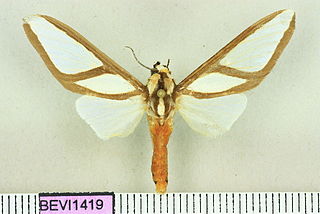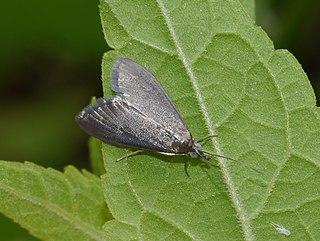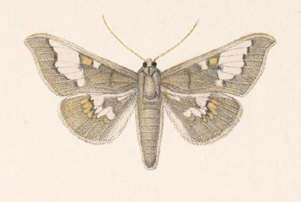
Pyrausta sanguinalis, the scarce crimson and gold, is a moth of the family Crambidae. The species was first described by Carl Linnaeus in his 1767 12th edition of Systema Naturae. It is found across western Europe as far east as southern Finland. In the British Isles it was formerly found at multiple coastal locations in north-west England and Scotland, however it has now much declined and it is restricted to a few locations in Northern Ireland, in the west of Ireland, and a single site on the Isle of Man.

Robinsonia is a genus of moths in the family Erebidae. The genus was erected by Augustus Radcliffe Grote in 1866.

Pyrausta is a speciose genus of moths of the family Crambidae. The genus was erected by Franz von Paula Schrank in 1802.

Polygrammodes is a genus of moths of the family Crambidae.

Thliptoceras is a genus of moths of the family Crambidae. The genus was erected by William Warren in 1890.

Thyrgis ruscia is a moth of the subfamily Arctiinae. It was described by Herbert Druce in 1895. It is found in Bolivia and Ecuador.
Pachydota saduca is a moth of the family Erebidae. It was described by Herbert Druce in 1895. It is found in Costa Rica, Colombia and Bolivia.

Pyrausta demantrialis is a moth in the family Crambidae. It was described by Herbert Druce in 1895. It is found in the United States, where it has been recorded from Arizona, Florida, Indiana, Michigan, New Mexico, North Carolina, Pennsylvania, Texas and West Virginia. It has also been recorded from Mexico (Guerrero), Ecuador and Venezuela.
Bocchoropsis pharaxalis is a moth in the family Crambidae. It was described by Herbert Druce in 1895. It is found in Costa Rica.
Eurrhyparodes splendens is a moth in the family Crambidae. It was described by Herbert Druce in 1895. It is found in the US from Arizona and Texas through the Mexican states of Xalapa, Veracruz, Morelos, Guerrero and Yucatán to Guatemala and Costa Rica.
Pantographa suffusalis is a moth in the family Crambidae. It was described by Herbert Druce in 1895. It is found in Mexico and Costa Rica.
Pilocrocis cryptalis is a moth in the family Crambidae. It was described by Herbert Druce in 1895. It is found in Honduras, Costa Rica, Panama and French Guiana.
Pilocrocis cyrisalis is a moth in the family Crambidae. It was described by Herbert Druce in 1895. It is found in Panama and Costa Rica.
Polygrammodes croesus is a moth in the family Crambidae. It was described by Herbert Druce in 1895. It is found in Guatemala.
Polygrammodes senahuensis is a moth in the family Crambidae. It was described by Herbert Druce in 1895. It is found in Guatemala.
Polygrammodes cyamon is a moth in the family Crambidae. It was described by Herbert Druce in 1899. It is found in Oaxaca, Mexico.
Polygrammodes nervosa is a moth in the family Crambidae. It was described by William Warren in 1889. It is found in Brazil and Ecuador.
Polygrammodes quatrilis is a moth in the family Crambidae. It was described by Herbert Druce in 1902. It is found in Venezuela and Colombia.
Psara prumnides is a moth in the family Crambidae. It was described by Herbert Druce in 1895. It is found in Mexico, Costa Rica, Honduras and Panama.

Siga pyronia is a moth in the family Crambidae first described by Herbert Druce in 1895. It is found in Panama and Costa Rica.








